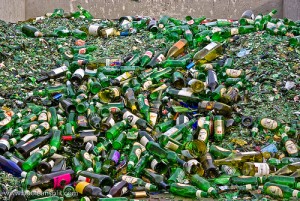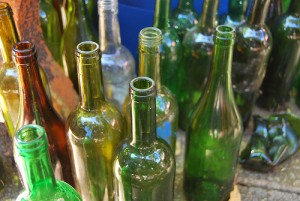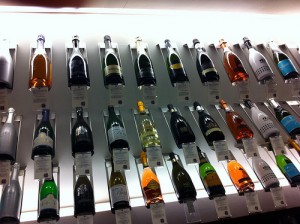In these days of increasing focus on efficiency and sustainability, wineries are frequently looking for ways to improve and to lower their overall carbon footprint. In this blog, we’ve talked about ways that can happen in the vineyard in regards to organic and biodynamic practices and also in regards to wastes and recycling and how wineries can utilize and reuse industry waste to create new products. Another way wineries are trying to reduce their carbon footprint is to reduce the amount of glass used in their wine bottles.
Bottles made with less glassshould lower the energy costs associated with the bottle production, as well as reduce the costs of recycling the bottles when no longer needed. Lower weight bottles would also lighten the loads being transported from winery to retail outlet, which would theoretically reduce the
amount of gasoline needed to perform the transport, reducing energy costs and emissions over time.
In addition to bottle weight, bottle color has been coming under some scrutiny as well, in particular the darker colored bottles which tend to require more energy to produce and recycle than lighter colored bottles. There has been some work looking at the stability of wine using lighter colored bottles, however, the information known regarding lighter colored bottles in concert with lighter weight on wine stability is few and far between. Lighter colored bottles may reduce the stability of the wine within them, and lighter weight bottles may result in a faster increase in the temperature of the wine than a thicker, more protective bottle.
Wine is frequently exposed to damaging light when in retail settings and when improperly stored at an individuals’ home, which is something that is often taken into consideration when choosing the bottle color for wine. It is the short wavelength radiation in particular that light gives off that can cause damage to the wine, in regards to sensory characteristics, color, and overall stability. There have been many studies examining this type of damage on wine stability, however, very little has been done to look at the actual pigment production of the wine and light impact. In general, pigments undergo oxidative reactions and damage when exposed to short wavelength radiation, which result in an overall degradation of the wine over time.
Previous studies have shown that clear glass provides little to no protection against the oxidation of some compounds in wine (specifically tartaric acid), while darker bottles such as antique green glass did provide some, but not complete, protection against this oxidation. The results of these studies indicate that bottle color may be a very important factor influencing the degradation of wine caused by light exposure. Even though these studies suggest that darker
bottles may protect against harmful light exposure, other studies have found that darker bottles actually increase the temperature of the wine at a faster rate than lighter colored bottles, which could have just as damaging an effect than light exposure.
The study presented today aimed to tease apart these temperature and light effects and how both effect the pigment development in white wine. Specifically, instead of using whole bottles, the researchers used fragments of each glass and used them as filters in between the wine which was kept at a constant temperature and the light source.
Methods
Chardonnay bag-in-box was commercially purchased for this study. The wine was enriched with either (+)-catechin or (-)-epicatechin at 100mg/L.
Wine bottles used were the following colors: Flint (clear), Arctic Blue, French Green, and Antique Green. Bottles for each color were both traditional weight (heavy) and newer lightweight.
Irradiation Set-Up:
- Wine samples were placed in a cuvette made of quartz, closed with a Teflon stopper, and placed in a UV/Vis Spectrophotometer and held steady at 45oC.
- A high-pressure Xenon arc lamp was positioned 145mm away from the wine sample with the light pointed directly into a window on the cuvette. This distance resulted in a total light intensity on the wine samples (without bottle protection) of 0.60W.
- Small pieces of glass from the wine bottles were used as filters and placed directly in front of the cuvette holding the wine. This was done to simulate the wine being inside the bottle without introducing the temperature effect wine experiences when enclosed in the bottle.
- Several types of radiation and/or color filters were used in this experiment and fell under the following wavelengths: visible radiation (>400nm), ultraviolet radiation (300-400nm), yellow light filter (>520nm), red light filter (>620nm), and orange light filter (>540nm).
Results
- To tease out the effects of temperature on pigment development, Chardonnay wine with (-)-epicatechin added was placed in the spectrophotometer in complete darkness for 6 hours and at temperatures ranging from 25oC to 60oC.
- There was a small increase in absorbance at 480nm starting at 45oC and becoming even greater at 50oC and 60oC.
- Temperatures of 50oC and 60oC were accompanied by detectable sensory changes as well as noticeable color changes.
- For the remainder of the experiments focusing on light, the 45oC temperature was used since this was the first temperature where notable damage to the wine occurred, and also is similar to conditions of a bottle of wine being left in the truck of a car for several hours or a bottle being placed in direct sunlight on a very hot day.
- To examine the impact of light on pigment development, Chardonnay wine with (-)-epicatechin added was placed in the spectrophotometer and exposed to the full wavelength of the light (i.e. no filters used) for 6 hours.
- There was a significant increase in absorbance in the visible light region of the spectrum as well as an associated color change to the wine.
- Wine composition was significantly more altered when exposed to low wavelengths in the visible and ultraviolet regions than any other wavelength.
- Minor changes were noted using red, orange, and yellow filters, but were generally not thought of as significant.
- To determine if low wavelength radiation was more important than higher temperatures on wine stability, Chardonnay wine with (-)-epicatechin added was placed in the spectrophotometer either in complete darkness or exposed to UV light at either 45oC or 25oC for 360 minutes
- At 45oC, the absorbance at 480nm for the wine samples exposed to UV light was 0.061, while the absorbance at 480nm for the wine samples kept in complete darkness was significantly less at 0.005. The same trend was noted for 25oC; however, the difference between darkness and light exposure was significantly less.
- These results indicate that higher temperatures lead to faster rates reaction, but not to reaction products that have different absorbance characteristics.
- At 45oC, the absorbance at 480nm for the wine samples exposed to UV light was 0.061, while the absorbance at 480nm for the wine samples kept in complete darkness was significantly less at 0.005. The same trend was noted for 25oC; however, the difference between darkness and light exposure was significantly less.
- All these results suggest that low wavelength radiation is extremely important in pigment production of white wine.
Bottle Color and Weight and Pigment Development
- There was a small impact of bottle weight on light transmission characteristics.
- Chardonnay with (-)-epicatechin added was placed in the spectrophotometer and irradiated with light <400nm at 45oC and protected using the various glass filters.
- More color developed in wine protected by lighter bottles than heavier bottles.
- The greatest development in color was with the Flint (clear) bottle, followed by the French Green bottle, then the Antique Green bottle.
- More color developed in wine protected by lighter bottles than heavier bottles.
- Even though the Antique Green bottle resulted in the least color development in wine, it should be noted that it still did not completely protect against the irradiation and thereby does not completely protect against the chemical changes brought on by this light exposure.
- The effect of bottle weight on color development in white wine samples was only minor, accounting only for less than 10% of the total change in the samples.
Side note: This study also examined the effect of added riboflavin on pigment enhancement in white wine, however, due to space considerations; I will not be presenting those data in this post). If you’re curious about it, I can always do a follow-up post on that sub-topic. Just ask!
Conclusions
The results of this study indicate that while the combination high temperatures and low wavelength and UV light exposure can have devastating effects on wine color and stability, light exposure alone can also elicit color changes in wine. Also, while not even the darkest colored glass completely protected against color change damage due to light exposure, the darkest bottles did protect
against more than the clear bottles. In terms of glass color, wine color development was most affected by Flint (clear) glass, followed by Arctic Blue, French Green, and finally Arctic Green glass.
The authors also claimed that based on their results, wine bottle weight only has a minor impact on color development in white wine. Since bottle weight does not appear to affect wine color development to a great degree, commercial wineries that focus on mass production of large quantities of “drink now” wines may find it beneficial to switch to lighter weight bottles (if they have not already done so). Switching to lighter weight bottles would likely result in lower production and recycling costs, as well as a lowered carbon footprint, all the while maintaining a relatively constant level of wine color stability, with only minor changes possibly occurring under extreme light and temperature exposure conditions.
Though red wines were not studied in these experiments, it’s possible that red wines may be stored in lighter bottles and still maintain wine color stability. Since red wines are better able to resist color changes due to their significantly higher levels of anthocyanins (and other pigment-enhancing chemical compounds), it is possible that these minor color changes noted for white wines would be even more minuscule or even nonexistent in red wines. Of course, this study would need to be repeated with red wines to be certain, but I predict we’d see even less of a color change by using red wines.
Regardless of what type of bottle the wine is stored in, one should always practice “safe wine storage” techniques and keep bottles in a relatively light-free and temperature-controlled space. If one is planning on storing wines for a long period of time, a wine cellar or wine refrigerator is ideal. However, many times neither of these is possible, so it is important to try and keep wines in the darkest and coolest place possible (maybe the back corner of a dark closet).
Source: Dias, D.A., Smith, T.A., Ghiggino, K.P., and Scollary, G.R. 2012. The role of light, temperature, and wine bottle colour on pigment enhancement in white wine. Food Chemistry 135: 2924-2941.
I’d love to hear what you all think of this study. Does this study raise further questions for you? Do you have any first-hand experience to anything discussed in the study? Please leave your comments and join in the discussion!




2 comments for “The Effect of Light and Temperature Exposure on Wine Color Development: The Role of Bottle Color and Weight”